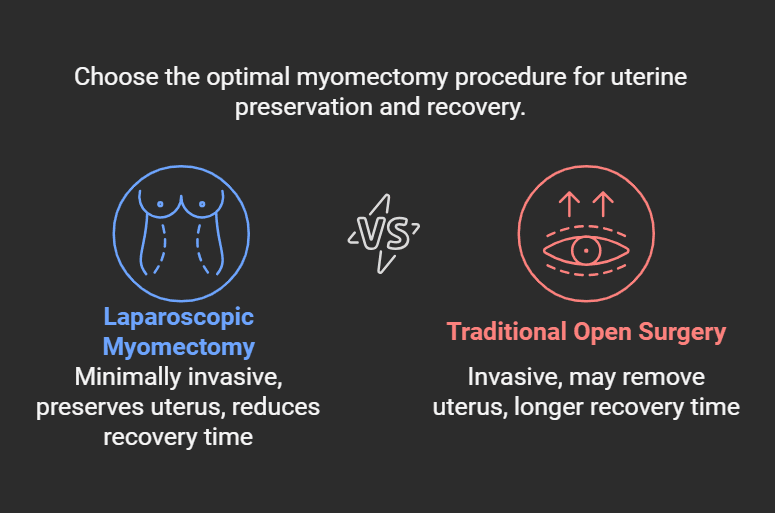Laparoscopic Myomectomy Surgery
Laparoscopic Myomectomy is a minimally invasive surgical procedure designed to remove uterine fibroids while preserving the uterus. It involves making small incisions in the abdomen through which a laparoscope—a slender tube with a camera—is inserted to visualize and operate inside the pelvic cavity.
This advanced technique is one of the most effective types of myomectomy procedures, offering reduced recovery time, less pain, and minimal scarring compared to traditional open surgery. It is ideal for women who prioritize uterine preservation, particularly for fertility purposes.

Who Needs a Laparoscopic Myomectomy?
This procedure is highly recommended for women facing symptoms caused by fibroids, such as:
- Heavy or Prolonged Menstrual Bleeding – Fibroids can enlarge the uterus, leading to excessive blood flow during menstruation.
- Pelvic Pain or Pressure – Large fibroids can press against pelvic organs, causing pain and discomfort.
- Infertility or Recurrent Miscarriages – Fibroids within the uterine cavity can interfere with implantation and pregnancy.
- Urinary and Bowel Problems – Fibroids pressing on the bladder or rectum may cause frequent urination or constipation.
By undergoing laparoscopic myomectomy surgery, these issues can be effectively addressed without compromising uterine function.
Procedure Overview – How is Laparoscopic Myomectomy Performed?
Step 1: Anesthesia – The procedure is performed under general anaesthesia, ensuring the patient is completely unconscious and pain-free during surgery.
Step 2: Small Incisions – Tiny incisions (5–10 mm) are made in the abdomen, usually near the navel and lower abdomen, to insert the laparoscope and surgical instruments.
Step 3: Visualization and Fibroid Removal – The laparoscope provides a magnified view of the uterus, enabling the surgeon to locate and extract the fibroids with precision. Larger fibroids may be cut into smaller pieces (morcellation) for easier removal.
Step 4: Uterine Reconstruction – Once the fibroids are removed, the uterus is carefully sutured to restore its shape and strength, preserving its functionality.
Step 5: Closure – The incisions are closed with dissolvable stitches or surgical glue, leaving minimal scars.
Benefits of Laparoscopic Myomectomy Surgery
Choosing laparoscopic myomectomy surgery for fibroid removal has immens benefits.
- Minimally Invasive Approach – Smaller incisions result in less pain, minimal scarring, and faster healing.
- Preserve Uterine Function – Ideal for women who plan to conceive in the future.
- Shorter Hospital Stay – Most patients are discharged within 24–48 hours.
- Faster Recovery – Return to normal activities within 2–4 weeks.
- Lower Risk of Infection and Blood Loss – Compared to traditional open surgery.
- Improved Quality of Life – Relief from fibroid-related symptoms like heavy bleeding and pelvic discomfort.
Recovery Tips for Faster Healing
- Rest Adequately: Take it easy for the first few days and avoid strenuous activities for smooth recovery after laparoscopy mayomactomy.
- Follow Medication Guidelines: Use pain relievers as prescribed to manage discomfort.
- Stay Hydrated and Eat Nutritious Foods: A balanced diet supports healing and boosts energy levels.
- Avoid Heavy Lifting: Do not lift heavy objects for 4–6 weeks to prevent strain.
- Keep the Incision Area Clean: Follow your doctor’s instructions for wound care to avoid infections.
- Attend Follow-Up Appointments: Regular check-ups help monitor healing progress and address any concerns.
- Plan Pregnancy After Recovery: Wait 3–6 months before trying to conceive to allow the uterus to heal completely.
Robotic Myomectomy – An Alternative Approach
For some women, Robotic Myomectomy may be a suitable alternative to traditional laparoscopic surgery. This procedure uses a robotic-assisted surgical system to perform highly precise movements during fibroid removal. The benefits include:
- Enhanced Precision: Robotic arms provide improved dexterity and control.
- Minimal Scarring and Pain: Similar to laparoscopic surgery but with finer incisions.
- Shorter Recovery Time: Patients often recover faster compared to open surgery.
- Ideal for Complex Cases: Suitable for patients with large or multiple fibroids.
While Robotic Myomectomy offers advantages, it may not be necessary for all cases. A detailed consultation with your surgeon will help determine the best approach based on the size, number, and location of fibroids.
Why Choose Dr. Pankhuri Gautam?
Dr Pankhuri Gautam is a highly skilled gynaecologist and laparoscopic surgeon in Jaipur specializing in minimally invasive procedures. With years of expertise in laparoscopic myomectomy surgery, she has successfully treated numerous patients dealing with fibroid-related symptoms.
Expertise in Minimally Invasive Techniques: Dr. Gautam uses the latest technologies to ensure precision and faster recovery.
Patient-Centric Approach: She focuses on providing personalized care, addressing every patient’s unique concerns and fertility goals.
High Success Rates: Her experience and attention to detail have resulted in excellent outcomes for patients seeking fibroid removal.
Compassionate Care: From diagnosis to post-operative recovery, Dr. Gautam ensures a smooth and stress-free journey for her patients.
Take the First Step Toward Better Health Today!
Don’t let fibroids affect your quality of life or fertility goals. Take control of your health with Laparoscopic Myomectomy Surgery—a safe, effective, and minimally invasive solution.
Consult best female gynecologist in Jaipur Dr. Pankhuri Gautam today for expert guidance and personalized care. Book your appointment now and take the first step toward a healthier, fibroid-free future!
